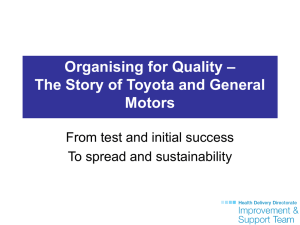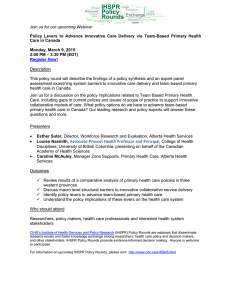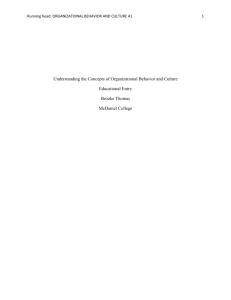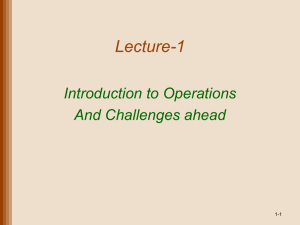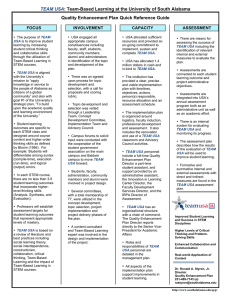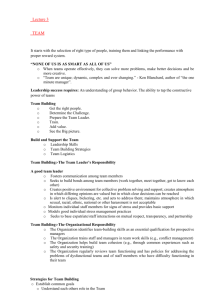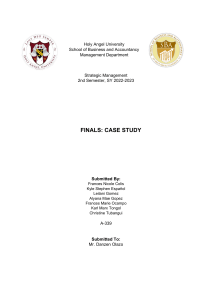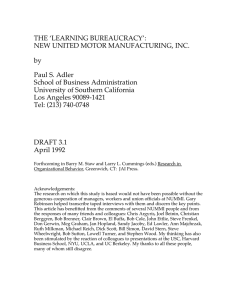15.660 Strategic Human Resource Management MIT Sloan School of Management
advertisement
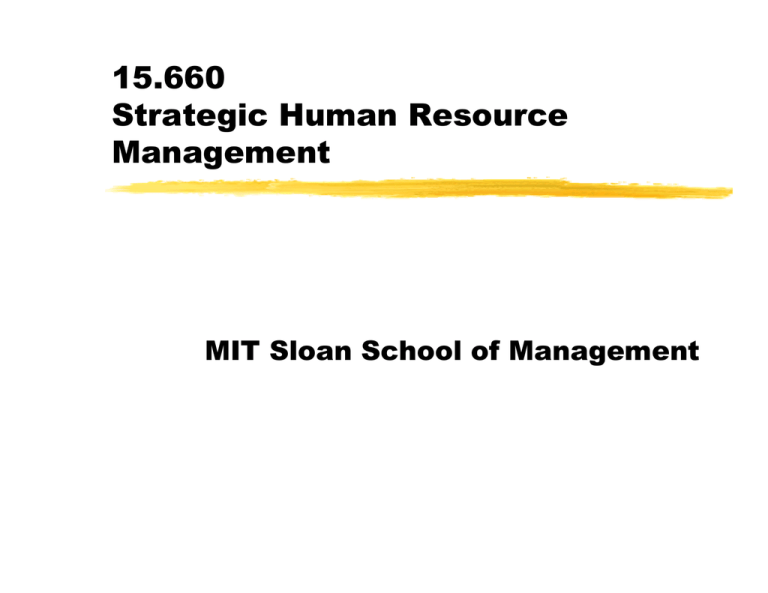
15.660 Strategic Human Resource Management MIT Sloan School of Management Two ways of managing Traditional ? ? ? ? ? Narrow job definitions Hire/Fire Adversarial atmosphere Managers think, employees execute No employee role in governance High Performance ? ? ? ? ? Flexible jobs Teams Joint Problem Solving Employee participation in decision-making High levels of training NUMMI Case Discussion NUMMI • NUMMI produces an average of 87 cars/worker vs. approximately 50 for Saturn and Buick City, General Motors’ most productive plants. • Since 1983, General Motors has spent over $80 billion on automation to improve the quality and productivity of their manufacturing plants. • In 1998, a 58-day strike at G.M. idled 200,000 workers and cost the company an estimated $2.5 billion. NUMMI Compared with Other Auto Plants (1986) Plant Productivity (Hours/Unit) Quality Automation Level (Defects/100 Units (0=none) Honda, Ohio 19.2 72.0 77.0 Nissan, Tennessee 24.5 70.0 89.2 NUMMI, California 19.0 69.0 62.8 Toyota, Japan 15.6 63.0 79.6 GM, Michigan 33.7 137.4 100.0 GM, Massachusetts 34.2 116.5 7.3 Source: John Krafcik, “Triumph of the Lean Production System”, Sloan Management Review, 1988, Volume 3, pp. 144-52. Toyota’s Commitment to Learning “All the organizations we studied that are managed according to the Toyota Production System share an overarching belief that people are the most significant corporate assets and that investments in their knowledge and skills are necessary to build competitiveness.” Steven Spear & Kent Bowen Harvard Business Review September-October, 1999 Training in World Auto Plants Ownership/ Location Training Hours: Training Hours per Year: First 6 Months for Workers with >1 Year New Workers Experience Japanese/Japan 364 76 Japanese/North America U. S./North America U. S./Europe 225 52 42 31 43 34 European/Europe 178 52 Newly Industrialized Countries Australia 260 46 40 15 SOURCE: MacDuffie and Kochan, Industrial Relations, 1995, p. 156 From the NUMMI Team Handbook Our HR philosophy guides us in the development of our full human potential to enable us to build the highest quality automobiles at the lowest possible cost by: • Recognizing our worth and dignity • Developing our individual performance • Developing our team performance • Improving our work environment NUMMI’s Core Values • Customer Satisfaction (quality and cost) • Dignity • Trust • Teamwork • Consistency • Frugality • Continuous Improvement • Simplicity • Harmony Mini-Lecture Teams Effective Use of Team-Based Systems ? ? ? ? ? ? What is a team-based system? Costs and benefits of using teams? What is the leader’s role in a team-based organization? What skills are needed for teams to function effectively? How can you introduce a team-based system? Overall lessons learned? What is a Team? A A team team is is aa small small number number of of people people with with complementary complementary skills skills who who are are committed committed to to aa common common purpose, purpose, performance performance goals, goals, and and approach approach for for which which they they hold hold themselves themselves mutually mutually accountable. accountable. John Katzenbach and Douglas Smith, McKinsey & Company The Wisdom of Teams Harvard Business School Press, 1993 Working Groups Versus Teams WORKING GROUP ? ? ? ? ? ? ? TEAM Strong, clearly-focused leader Individual accountability ? Group’s purpose is same as the organization’s Individual work products Runs efficient meetings ? Measures performance in terms of larger firm Discusses, decides, and delegates ? ? ? ? ? Shared leadership roles Individual and mutual accountability Specific purpose for which the team is responsible Collective work products Open-ended meetings for problem-solving Performance measured on team products Discuss, decide, and work together Common Team Responsibilities ? ? ? ? ? ? ? ? ? ? ? Quality improvement Cross-training Scheduling (Production) Safety Process improvement Measurement/goal-setting Budget/expense control Selection Coordination with others Customers and suppliers Performance appraisal 100% 85% 80% 70% 70% 75% 50% 55% 50% 60% 50% Manz and Sims (1993) Costs/Benefits of Using Teams Benefits ? ? ? ? Bring together complementary skills and experiences Provides for flexibility Social benefits: fun, commitment Less resistant to change Costs ? ? ? ? Coordination costs Personal discomfort and conflict Diffusion of responsibility (freeriders and social loafing) Risk seeking What is the role of the leader in a team-based system? • Ask questions • Get the group to solve problems • Promote real participation • Help resolve conflict • Train others • Positive reinforcement • Encourage high performance goals • Encourage self-evaluation • Tell the truth, even when it’s disagreeable • Liaison with higher management What Effective Team Leaders Do ? ? ? ? ? ? Keep purpose, goals, and approach relevant and meaningful Build commitment and confidence Manage the level and mix of skills Manage relationships with outsiders Create opportunities for others Do real work Team Development S S S = Supervisor S Mature Experienced S Transitional Start Start -- up up C. Manz & H. Sims Business Without Bosses John Wiley, 1993 What types of skills and training are required for a team-based system? Training for Team Effectiveness ? ? ? ? ? ? ? ? Meeting skills, time management Conflict management Problem-solving, TQM Group dynamics, team building Change management Coaching and feedback Business knowledge (e.g., customer service) Technical skills Evidence on Team Effectiveness ? ? ? ? ? ? ? ? ? Cost savings (labor, materials) Productivity Quality Customer service Speed and cycle time Innovation Safety Decreased absenteeism and turnover Decreased worker’s compensation claims Pros Pros and and Cons Cons of of aa Team-Based Team-Based Approach? Approach? Pros Cons Lessons Learned: Implementing Team-based Systems High Performance Team Real Team Impact Working Group Potential Team PsuedoTeam Team Performance Some Lessons Learned the Hard Way ? ? ? ? ? ? ? ? ? ? ? ? ? Organizations often expect too much, too soon. Things often get worse before they get better. Managers and supervisors are threatened. A new perspective on leadership is required. Need to begin with a clear philosophy and purpose. Technical people often see themselves as losers. Implementation needs careful planning. Employees need technical and behavioral skills. Greenfield sites are easier than retrofits. Continuous training is essential. Stability is crucial; turnover is deadly. May need new systems - especially MIS. Facilitation can help at the beginning. Takeaways ? ? ? Teams need to be driven by a clear vision and purpose--why are we using them? Training and group process skills are important for groups to succeed. Team-based organizations need teambased systems, culture, and leadership-not just structure. Another Example Saturn Source: Rubenstein and Kochan Situating Saturn ? ? ? ? Grew out of GM-UAW 1980s workplace experiments with QWL, teams, NUMMI GM couldn’t build small cars profitably High level of trust built up between UAW leader Don Ephlin & GM’s Al Warren Both willing to champion a new approach Most far-reaching & controversial labor relations & org. design experiment in the U.S of the past quarter century Saturn’s Evolution ? 1990-1996: ? ? ? ? 1996-99: ? ? ? ? ? Great customer reaction & high satisfaction Profits and Productivity--varied with volume “A new kind of union” adding value Delays & conflicts over new products Wilmington plant opens Difficult negotiations of decision-making & performance pay. 2000: New Company & Union Leadership Current challenge: How to be more integrated in GM and yet retain sufficient independence to sustain the partnership and its competitive advantage. Lecture High Performance Work Systems Adopting High Performance Work Systems CHARACTERISTICS OF INNOVATORS ? YOUNGER ? COMPETE INTERNATIONALLY ? PART OF LARGER ORGANIZATION ? HIGH SKILLS TECHNOLOGY ? EMPLOYEE ORIENTED VALUES ? “HIGH ROAD” SUPPORTING HUMAN RESOURCE PRACTICES ? PAY FOR SKILL ? GAIN SHARING ? PROFIT SHARING ? HUMAN RESOURCE DEPARTMENT IMPORTANT ? TRAINING HIGH PERFORMANCE WORK SYSTEMS 1997 60 50 40 30 20 10 0 Quality Circles Rotation Teams Two of Three PERSISTENCE OF WORK SYSTEMS 1997 YES YES NO 77.7% 49.5% 1992 NO 22.3% 50.5% Source: Osterman, Industrial and Labor Relations Review, January 2000 GAINS FROM TRADITIONAL ORGANIZATION ? ? ? ? Economies of scale from long standardized runs Control/Predictability Minimum training Less organizational disruption POTENTIAL SOURCE OF GAINS ? ? ? ? ? Tap into workforce ideas and creativity Build commitment and effort More nimble/flexible Eliminate layers (e.g. quality supervisors) Speed up and peer pressure BARRIERS ? ? ? ? Constituencies resist Teams are hard to create Skepticism of capital markets Small and medium firms lack time and resources QUESTIONS TO ASK IN MAKING CHOICE ? ? ? ? How standardized or predictable is the environment? How flexible is the production technology? What does it take to recruit and retain employees? Do employees have requisite skills or can they be trained? How willing are you to create organizational disruption? Key Measurement Issues ? ? ? ? ? ? ? Definitions of Terms Mail/Phone/In-person Surveys Sampling Frame of Employers Sampling Frame of Occupations Penetration Rate Report Fraction of Employers or Fraction of Employees Response Rate and Bias Issues in Assessing Performance ? ? ? ? ? ? ? Unit of Analysis ? Group, Process, Establishment, Firm, Industry, Economy Performance Metric Time Period of Measurement Additional Controls Contingency Perspective Selections Bias and Fixed Effects Direction of Causality AUTO STUDY METHODOLOGY ? ? ? 62 ASSEMBLY PLANTS, 1990 WORK SYSTEMS: TEAMS, EI GROUPS, JOB ROTATION, SUGGESTIONS RECEIVED AND IMPLEMENTED HRM POLICIES: HIRING CRITERIA(EXTENT OF OPENNESS TO NEW SKILLS), CONTINGENT COMPENSATION, TRAINING, STATUS BARRIERS AUTO STUDY METHODOLOGY ? OTHER CONTROLS: PRODUCT COMPLEXITY, AUTOMATION, USE OF BUFFERS, “JAPAN EFFECT” ? OUTCOMES: HOURS PER VEHICLE, DEFECTS PER 100 VEHICLES Source: MacDuffie GAINS FROM NUMMI FREMONT PRODUCTIVITY CONSUMER REPORTS RELIABILITY INDEX Source: Krafcik NUMMI 1978 1986 43.1 20.8 2.6-3.0 3.6-3.8 TAKAOKA 1986 18.0 3.8-4.0 CORRELATIONS OF PRODUCTIVITY AND QUALITY:AUTOS PRODUCTIVITY QUALITY WORK SYSTEMS .50 .50 HRM POLICIES .43 .67 Source: MacDuffie PRODUCTIVITY AND QUALITY: AUTOS ? REGRESSIONS SUPPORT CORRELATIONS ? INTERACTION (BUNDLES) OF HRM/WORK ORGANIZATION ARE MOST POWERFUL PREDICTORS Source: MacDuffie WORK ORGANIZATION AND PRODUCTIVITY IN STEEL : I ? ? ? ? OUTCOME: PERCENT UP-TIME SAMPLE: MONTHLY OBSERVATIONS ON 36 FINISHING LINES IN 17 PLANTS WITH STANDARD PRODUCT HR VARIABLES: TEAMS, HIRING, ROTATION, TRAINING, EMPLOYMENT SECURITY, SECURITY CONTROLS: VINTAGE, CAPITAL TYPE Source: Ichniowski, Shaw and Prennushi WORK ORGANIZATION AND PRODUCTIVITY IN STEEL:II ? ? METHOD: CLUSTERED HR PRACTICES INTO FOUR GROUPS, FROM MOST TO LEAST TRADITIONAL ESTIMATED CROSS SECTION AND FIXED EFFECT REGRESSIONS Source: Ichniowski, Shaw and Prennushi WORK ORGANIZATION AND PRODUCTIVITY IN STEEL:III ? MOST TRADITIONAL: UPTIME= 88% ? MOST TRANSFORMED: UPTIME=98% ? A MOVE FROM LEVEL 2 TO LEVEL 4 MAINTAINED FOR TEN YEARS=$10 MILLION Source: Ichniowski, Shaw and Prennushi WORK ORGANIZATION OF CUSTOMER SERVICE REPRESENTATIVES IN TELECOMMUNICATIONS ? SAMPLE OF TEAMS AND TRADITIONAL CSRS IN ONE FIRM ? HELD CONSTANT PERSONAL CHARACTERISTICS Source: Batt RESULTS FOR CSR’S TRADITIONAL TEAMS AVERAGE MONTHLY SALES $5010 5783 % OBJECTIVES MET 104% 108% Source:Batt Conclusion ? Next Class: ? The HR Function
